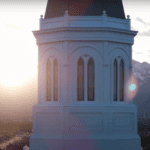![]()
Religious Art: Symbols of the Divine
By Daniel C. Peterson and William J. Hamblin
Today our world is overwhelmed with an almost infinite number of images-too many degrading and disgusting; others merely banal. Art in many of its forms has largely been co-opted by commerce and advertising in the never-ending quest to sell one more product. Yet, throughout most of history the vast majority of art has been based on religious themes and patronage.
The earliest evidence we have of human religious belief is found in Neolithic art, including carvings of gods or goddesses or paintings in sacred caves such as Lascaux in southern France. For thousands of years thereafter, attempts to represent the sacred through art have remained a fundamental element of religious practice in nearly all religions of the world.
All religions have non-verbal ways of unfolding the sacred, often including music, dance, ritual, art and architecture. When properly presented and understood, such activities are often believed to have real spiritual power. Religious art can be seen as a language composed of a complex symbol-system-known as iconography-that communicates important truths to believers who are able to understand and internalize those symbols. Indeed, some religions would maintain that the higher truths of the sacred can best be communicated through the symbols of art or ritual.
To understand the role of religious art in history it is important to remember that until the invention of printing-and indeed for several centuries thereafter-the vast majority of the people of the world were illiterate. Although they could hear the sacred stories and teachings of their faith, the only aid to memory was art. For medieval Christians, religious art was described as the scripture of the illiterate. The galleries and rooms of churches and temples throughout the world were lined with artistic representations of scripture as a fundamental way to teach spiritual truths.
On the other hand, some religions, such as Judaism, Islam, or Christian have iconoclastic elements, with formal prohibitions on depicting the image of God in art. But even so, art plays an important role in worship. Although the ancient Israelite temple did not contain an image of God, it nonetheless was filled with art depicting sacred trees and cherubs. In Islamic art the sacred is often depicted by complex interwoven abstract geometric patterns symbolizing the infinite power of God, or by intricate calligraphy depicting the words of God.
Religious art often served as a gateway to unseen worlds, whereby the viewer could see into the sacred past or future, or even into heaven or hell. Thus, for example, Michelangelo’s glorious Sistine Chapel tells the sacred history of the cosmos from creation to the Last Judgment. The great moments in sacred history-a vision of God or angels-although witnessed by only a few, but could be indirectly experienced through art. Some religious art was indeed actually based on the visionary experiences of the artists; the prophet Mani, founder of Manichaeism, was said to have made paintings of his visions.
In ancient religions, the artist was often seen as a conduit by which the power of God was made manifest through art. Indeed, many ancient artists were priests, monks or nuns who worshipped God through their art. Some religious art was said to have been made “without hands,” meaning that it was created by miracle, by divine power manifesting itself in the artist, or even painted by an angel. The significance of the image was not in the color and form, but in the spiritual power symbolized by and often thought to be residing in the image. From this ancient perspective the religious artist did not create art by the power of her own talent and genius. Rather, she was blessed with a talent allowing the creation of a spiritual image in imitation-and as a manifestation-of God’s infinite creative power.
To the modern untrained eye, ancient and medieval religious art can sometimes seem stilted and repetitious. For those willing to inform themselves of the lost language and symbolic meaning of religious iconography, the study of religious art opens a fascinating window into the sacred.

















